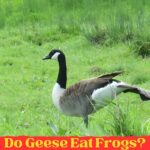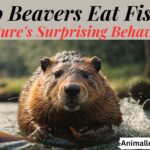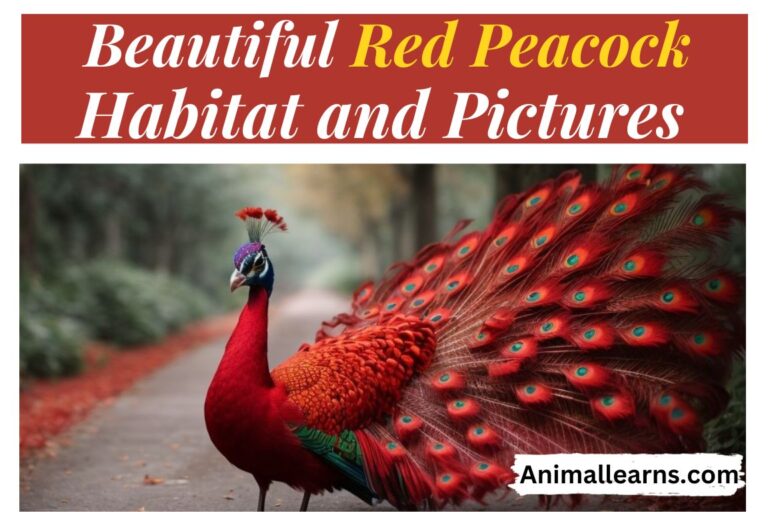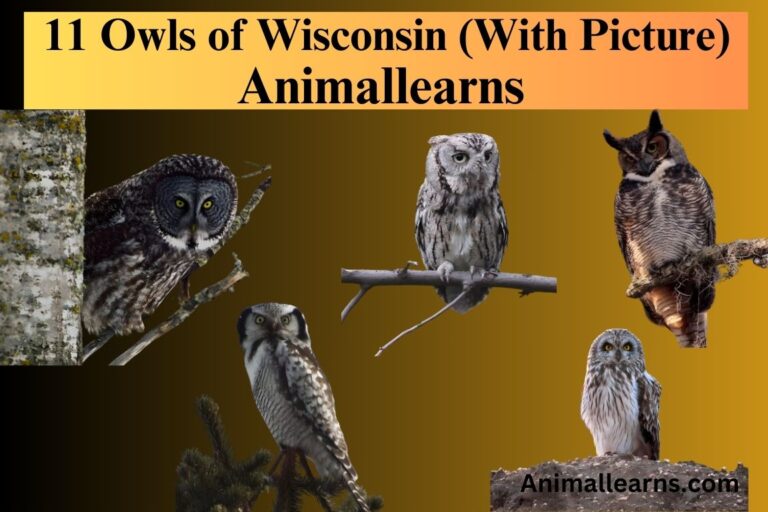A Guide to Feeding Geese | What Do Geese Eat Naturally?
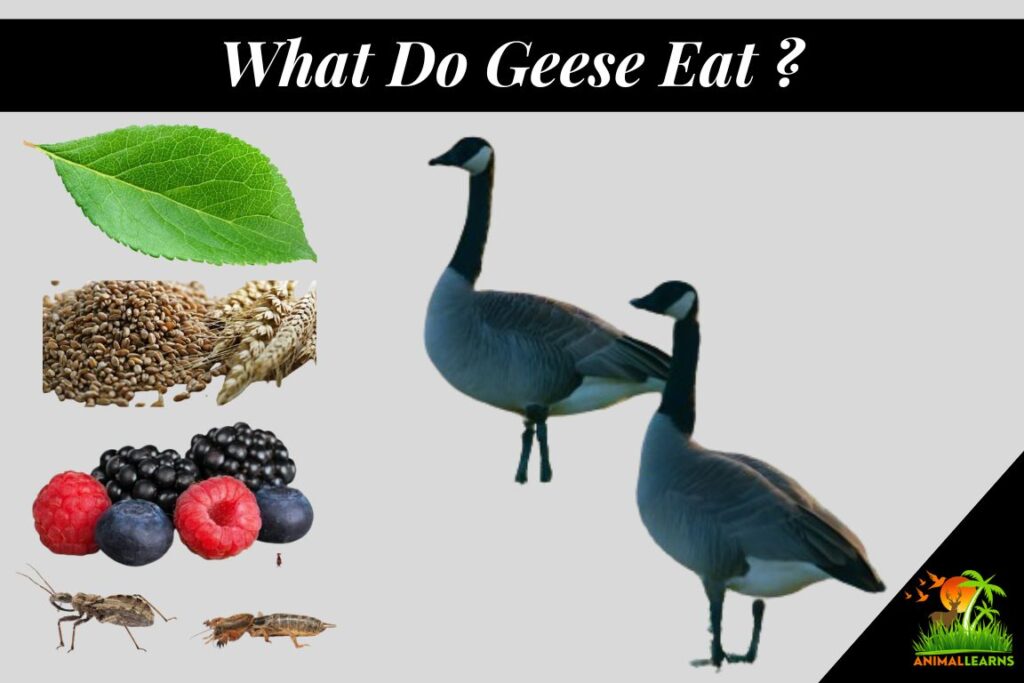
The answer to the query, “What do geese eat?” holds the key to that mystery. These massive birds have a great appetite for vegetative materials, particularly rhizomes, aquatic sedges, and fresh, nutrient-rich grass. They could also occasionally graze on berries. Compared to chickens and ducks, they have more effective gizzards and rather efficient digestive systems overall.
Insects, algae, grass, and water plants are all consumed by Canada geese. Although they are mostly herbivorous, they occasionally incorporate other things into their diet when needed.
For instance, during the winter months when their favored meals are less accessible, these birds will frequently eat more roots as adults and more insects while they are younger.
What Do Geese Eat?
Contents
| Geese Food | Geese Food |
| Grasshoppers | Corn |
| Eelgrass | Kentucky Bluegrass |
| Grains | Cattails |
| Earthworms | Sedge |
| Bermudagrass | wheat |
| Freshwater snails | Alfalfa |
The majority of a wild goose day is spent on land and in water feeding. Several grasses, clover, alfalfa, seed heads, wheat, maize, barley, and beans from fields (often foraged from fields after harvesting) make up a goose’s diet.
When berries are available, they will occasionally eat a few from hedgerows, but they often prefer to be in an open area where they can notice approaching predators.
The aquatic plants that geese consume include sedges and their seed heads, as well as submerged roots and rhizomes that they dig up from the mud. Even though they consume insects, geese don’t eat many insects.
To accumulate energy before beginning a lengthy journey, wild geese will eat more before migrating. They also consume more carbohydrates (grains and berries) throughout the fall and early winter to generate more heat to stay warm.
When food is short during the severe winter months, wild geese must expand their habitat. In the UK, they frequently go further south during very cold winters.
Wild Geese Feeding
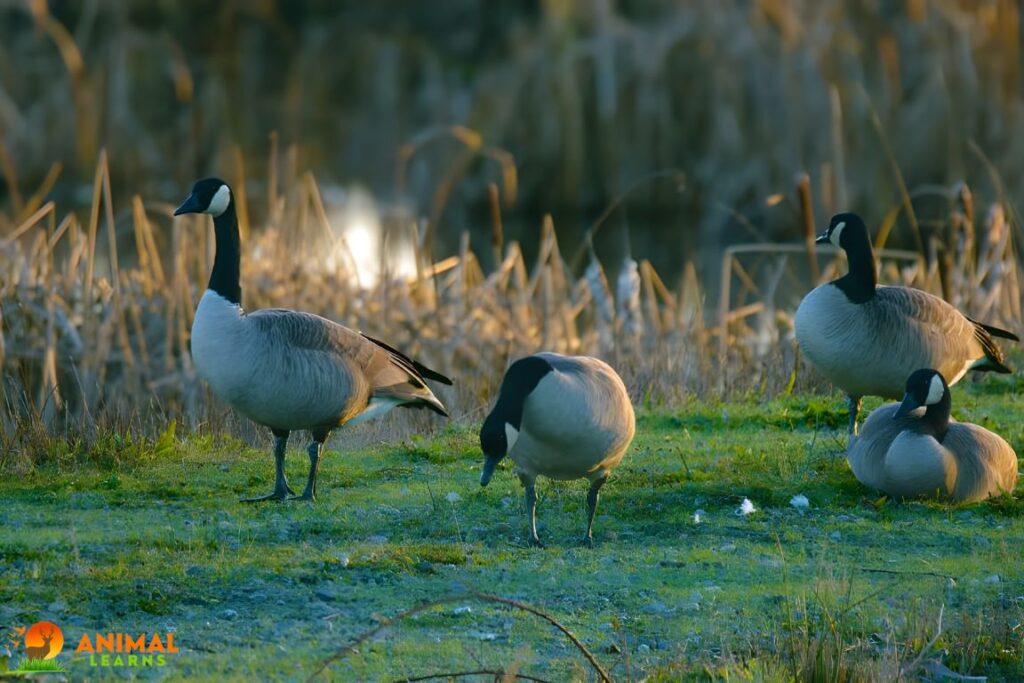
Seeds & Grains
Overgrazing throughout the fall can cause grasslands to become depleted, thus many geese adjust their diet to incorporate more seeds and grains during this time of year. These can provide the essential energy stores required prior to migration since they are high in carbs.
Popular grains and seeds that are harvested from the leftovers of agricultural harvests include oats, barley, wheat, corn, and maize.
Small Fish & Insects
Although they occasionally eat insects and tiny fish, geese do not consume a lot of animal products. When grazing on land, grasses will always be eaten before any insects that could be present in the pastures; nonetheless, it is not unheard of for some invertebrates to be eaten on occasion.
Aquatic Plants
While they aren’t well-known for their ability to dive or swim underwater, geese do occasionally tucker under the surface of the water in search of food. They consume rhizomes, sedges, and their seeds, and the roots and stems of rushes and reeds. Seaweed, kelp, and watercress are some of the most prevalent aquatic plants found in a goose’s diet.
Grasses
Grass is by far the most prevalent food source for geese in the wild. New shoots of grass will be chosen over longer, higher strands; short, fresh grass is desired. Harder grasses like alfalfa are typically less preferred for consumption than clover, bluegrass, orchard grass, timothy, and bromegrass.
Domestic Geese Feeding

You might wonder if it is reasonable to maintain domestic geese unless you are lucky enough to have a paddock, orchard, or something similar with around half an acre of grass for them to graze.
Making fields, lawns, and orchards fox-proof can also be difficult since domestic geese are unable to fly to safety. Even in the presence of a pond or lake, geese do not always flock to the water when alarmed and do not always eat close to the water’s edge.
Since geese enjoy grass, feeding them entails giving them a place to graze. Nevertheless, the nutrients differ significantly depending on the kind, length, and season of the grass. Because domestic breeds of geese, kept by people who raise poultry like me, are larger than wild geese and cannot go as far when confined, we must provide additional meals for our geese when they are fed at home.
Additionally, domestic geese weigh more than their wild counterparts. Since most domestic goose breeds are too heavy to fly, only a few numbers, like the Chinese goose, were lighter and bred to lay eggs. As a result, several breeds of geese were developed to be acceptable table-size sizers.
Wheat
If you have enough grass and can maintain it short, domestic geese can be fed mostly on it in the spring and early summer. Additionally, you may feed wheat at the bottom of a pail of water if you run out of excellent, clean grass. The wheat will become submerged.
A medium-sized goose will consume about 200g of food per day in the absence of grass.
My geese may take as much wheat as they like from a half-sized bucket that I give them, and they can also take as many of their layers of pellets from a hopper that is accessible at their discretion.
The benefit of putting wheat in water is that it keeps mice, rats, and crows away.
However, keep in mind that rodents require access to both food and water, so if you notice any signs of them, take out the food and water for the night.
What food can we give the geese to eat? Indeed, geese adore greens like lettuce, cabbage, and cauliflower leaves. Additionally, they will consume leftover veggies such as boiled potatoes, carrots, parsnips, etc.
Keep in mind that individual geese have varied tastes, so you may need to give them some time to discover what they enjoy.
Fruits and Vegetables
Fertilized geese benefit from receiving supplemental fruit and vegetable diets because they provide a greater range of minerals and vitamins. Among the most popular fruits are apples, bananas, watermelons, and ripe grapes; slice them into the right size pieces before serving. Leafy vegetables will also be readily consumed, such as lettuce greens, cabbage, and cauliflower leaves in moderation.
Grit & Calcium
When foraging in the wild, geese frequently eat tiny pebbles or stones from the lake bed. These are then kept in their gizzard, where they combine with digestive secretions to break down any food particles that are not digested into smaller bits.
It’s typically not required to provide a separate source of grit for geese because they can easily discover and consume it on their own, however a tray of coarse sand can be useful.
In addition to maintaining healthy bones and strong skeletons, calcium is essential to a goose’s diet during egg production to prevent fragile or weak eggshells. Geese will naturally obtain calcium from their diet of fresh lush greens while they are in the wild.
When it comes to breeding, domestic geese might benefit from calcium supplements, such as crushed oyster shells.
What Do Baby Canadian Geese Eat?

When delving into the feeding habits of baby Canadian geese, it’s essential to address the central inquiry: “What do geese eat? Goslings are young Canadian geese that can obtain food on their own as soon as they hatch.
Just like adults, they will favor grass for food since it is easily ingested and abundant. In their native grazing regions, they will occasionally eat mixed dandelions and clover.
Goslings will also consume whatever little insects they come across, including worms and mosquitoes. These insects offer a great source of protein to help the goslings eat what they require.
For the first several weeks of their lives, the goslings primarily stay on dry land to hunt for food, but eventually, they follow their mother into the water. Once there, they will adopt feeding behaviors consistent with adults and incorporate aquatic plants into their diet.
Seasonal Differences in Diet
Spring and Summer
The easiest seasons for geese to eat are spring and summer. There’s plenty of sedge and grass, and the shortest, tastiest young shoots are easily found, which is especially helpful when goslings hatch and start feeding with their parents.
In addition to eating bluegrass, alfalfa, and clover, geese often forage for seaweed, kelp, and watercress in bodies of water.
Dietary adaptations result from post-breeding weather variations and changes in the availability of natural food sources; high-energy seeds and berries take precedence over grasses and sedges. Geese start storing energy before migrating by consuming foods high in carbs, such as maize, wheat, barley, and seed heads.
Winter
Many geese will have temporarily relocated to milder wintering grounds by the time the harshest winter conditions arrive. There, they will likely continue to graze on pastures that haven’t frozen, if that’s still possible, but they’re more likely to be seen opportunistically foraging through agricultural land for any leftover crops, like corn and beans.
In certain areas, geese may be able to survive year-round due to climatic circumstances, and they may still have access to grasslands; however, typically, berries and seeds are consumed more often until the next spring.
It’s okay to give wild geese extra food in moderation throughout the winter, but it’s best to let them fend for themselves so they don’t get overly reliant on people.
How Do Canadian Geese Find Food?

The senses that Canadian geese use to locate food are not particularly sophisticated. Their ability to detect scents and discriminate between various meals is facilitated by their keen vision and sense of smell.
For the most part, Canadian geese graze on the flora on land to get sustenance. Since they don’t have teeth, they will bite the grass or plants before ripping away to shatter them.
They do have some similarities to other ducks in terms of tomia, as well as simple teeth-like projections on their bills and tongues that enable them to swiftly rip through plants.
While on the water, Canadian geese frequently search for and eat food. Similar to other ducks, they will paddle on the surface until they see something they want to eat, and then they will dive to catch it.
When they tip their bodies under the water to eat, leaving only their tails above the surface, this activity is referred to as upending. Similar to what they do on land, the geese pluck and rip the tender plants.
The geese don’t always hunt when it comes to consuming insects, mollusks, or other invertebrates. When these animals are around, they pounce on them haphazardly, especially if they can’t get their other favorite meals.
What Predators Eat Canadian Geese?
After answering the crucial issue of “what do geese like to eat?” (more specifically, “what do Canadian geese eat”), let’s look at what else enjoys eating geese. Not that these hardy birds of prey make things easy for apprehensions: similar to other ducks, they are known to be hostile animals, particularly when it comes to protecting their young. Nor are they all bellicose.
With their outstretched wings and deafening screeches, these geese will warn you away. If the threat fails to frighten the encroacher away, they will attack. They are not always protected by their threat show, even if it is sufficient to frighten off some predators.
Among the frequent predators of Canadian geese are:
| Predator Name | Predator Name |
| Foxes | Raccoons |
| Bears | Coyotes |
| Eagles | Bobcats |
| Crows | Ravens |
| Humans | Snakes |
| Skunks | Snapping turtles |
Predation is the biggest hazard to goslings, notably by eagles, snakes, and snapping turtles. Their parents can only shield them to a certain degree; they have no defenses against these animals.
Although people consider adult Canadian geese to be pests, regulations prevent them from being killed outright. Although the geese are occasionally killed in the surrounding areas, their number is by no means in trouble.
Although they are migratory herbivores, Canadian geese occasionally consume certain insects, invertebrates, and mollusks. They may be seen throughout North America, and they are well-known for their frightening displays and unusual coloring, which consists of a black head and white cheeks.
Like other wild animals, even though they are loud animals, they pose no harm to people as long as they leave them alone and maintain a safe distance.
“In this article, we explored the intriguing question, What do geese eat? delving into their diverse diet of grasses, grains, aquatic plants, insects, and occasionally small fish.”
FAQs
What kind of food do geese eat?
Naturally, geese consume water plants and grass. Small amounts of floating duck pellets, uncooked plain porridge oats, or mixed maize are all they require as additions to their diet.
What should you not feed geese?
To birds, bread, crackers, popcorn, and other items heavy in carbohydrates are like junk food. When birds eat them, they won’t look for other wholesome food. This may result in the birds becoming malnourished, which might lead to various health issues for adults and young birds alike.
Can geese eat rice?
Some items that geese like to eat are split peas, brown rice, whole oats, lentils, and tiny seeds.
What is the best food for geese?
As a result, feeding mealworms or freeze-dried crickets to ducks and geese will imitate their natural diet, which consists primarily of insects. Oats, birdseed, cracked corn, peas, lettuce, spinach, and kale are some more healthy possibilities.
Do geese need water?
Your ducks require easy access to clean drinking water, just like any other animal. A fresh water supply should be kept far from the water feature that ducks and geese swim and play in, deep enough for them to clean their beaks and nostrils as they drink, and replenish every day.
Can geese eat bread?
Grain-rich alternatives like as wheat, birdseed, lettuce, or other greens are considerably better for geese health. When geese are fed bread regularly, they will become malnourished and will eat junk food instead of natural food sources.


